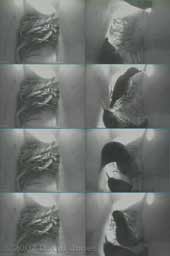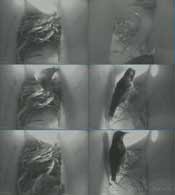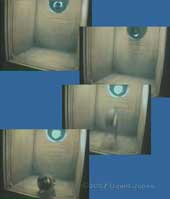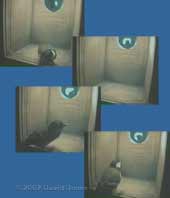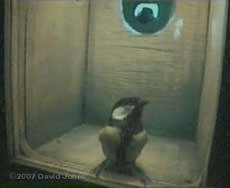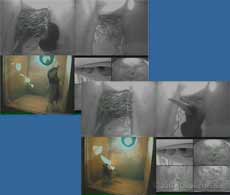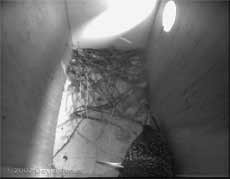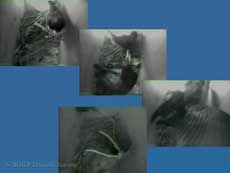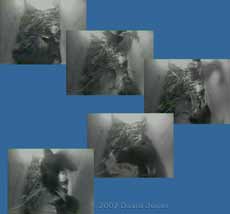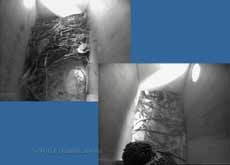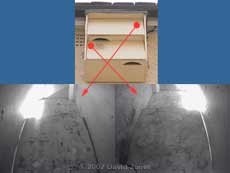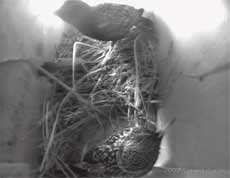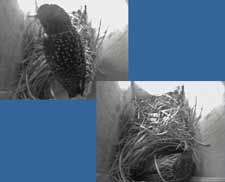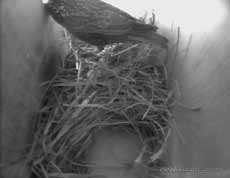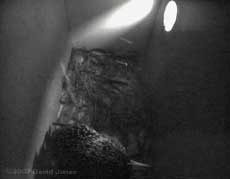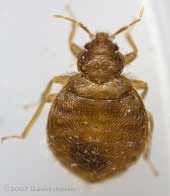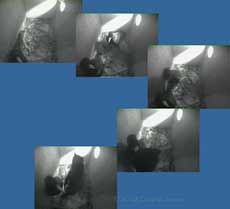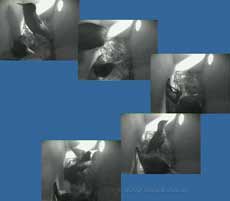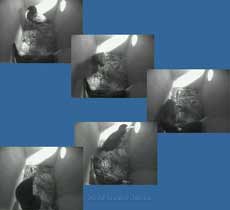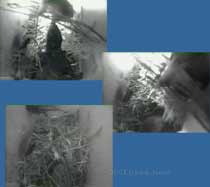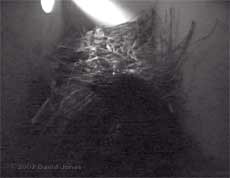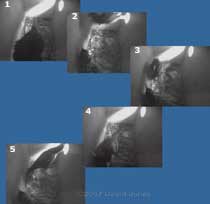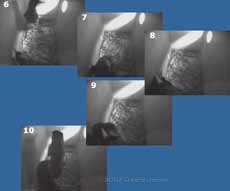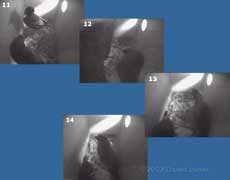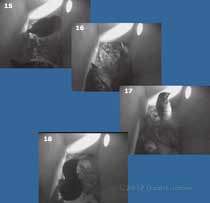Go to the last entry on this page Go to previous entry21 March - Last night's stay in box 2 ended when the occupant left at just after 6am, although during the next two hours the box was revisited six times, three visits coming immediately after a bird had been in box 1, with very little nest material brought in. This pattern continued until morning visits came to an end shortly before 10am and then there was the usual gap until the afternoon. After 2pm there were a small number of visits to both boxes as the afternoon progressed. Then, soon after four o'clock there was a visit to box 1 that seemed different. The bird seemed to spend more time investigating the nesting material near the entrance rather than spending time in the clear area. As 4.30pm approached, a bird entered box 2, had a quick inspection and moved to box 1, staying there only briefly.
Two minutes later a very different sequence took place in box 2. A bird entered and headed for the area below the camera. It appeared to be calling (I could see the feathers under its beak being puffed out - no sound, I'm afraid because of a technical hitch!), and moments later a second bird entered. Rather than being aggressive, the first bird (presumably a male) carried on singing as the second (presumably a female) looked around the box. She appeared to be dominant, sometimes towering over the first bird.
The encounter lasted the best part of two minutes before the second bird (the female?) left and almost immediately entered box 1, giving that an inspection while the first bird remained in box 2. The encounter was over after about half a minute and both birds left. I must sort out the Starling sound link tomorrow morning.
Over the next hour there were nine more visits by an individual bird, with six to box 1, before a single bird entered box 1 and settled down to roost at 5,48pm.
If you watched the webcam today you will have seen the House Martin cameras make an appearance. They are close to being operational now, but I've been having a power supply problem which didn't make an appearance while I was testing the cameras prior to installation. The cameras work fine, but I may need to sort out a replacement power supply for a couple of them.
22 March - First of all today, a matter of embarrassment and puzzlement as far as I am concerned - It's a matter of spotting the not-so-deliberate mistake - Yesterday morning I spotted a bird at the entrance of the Tit box just once, at around 6.30am (very early for that box). This morning, soon after 9am I had an e-mail from Mike Perry, who has followed past nesting in that box and is familiar with what to expect. He told me that a Great Tit had just been in the box (I had missed it) and that I should check the glass panel that separates the birds from the camera(s).
At this point everything looked normal, unless you are familiar with this view and look at the bottom image carefully.
It was only when, with its partner watching from the entrance, the Great Tit took a step forward that it was obvious that something was missing - the Glass!! It just stepped out of the box into the darkened 'technical' area of the observation area, returning moments later. It did this again before leaving, only to return for another adventure a minute or so later. It was several minutes more before the birds finally left the area around the entrance, and not much longer until I received the e-mail and headed to the box (with a certain sense of disbelief) to replace the glass. A bird appeared at the entrance again at 9.50am, but didn't enter the box this time. The nestbox has been in place at least ten years (with the first first webcam in 2000), and in all that time I have never managed to forget to replace the glass - and I cannot for the life of me think of how I managed to do it, or when. I haven't been doing anything in the box for three weeks or more. I just hope that the Great Tits haven't prepared plans for a dark extension to their nest! After that, the Starlings' day has been almost an anticlimax. The resident bird was looking out by 5.50am and left the box at 6.04am. There were just seven visits to box 1 and three to box 2 in the next three hours. Between 9 and 10am the count went up to 13 to box 1 but just two to box 2. Visits continued through to noon, with fifteen more entries to box 1 and just two to box 2.
10.43am saw the only time that two birds featured in the video, although they stayed in separate boxes.
A feature of the morning's visits to box 1 was the time spent selecting twigs from the area around the entrance, dropping them in the clear area and then shuffling them into the edge of the twig mass. This was repeated numerous times during prolonged visits. There were just a few visits in the two hours after noon, and then a gap before a single visit to box 2 at just after 4pm. The day came to an end around 5.18pm when a Starling entered box 1 briefly, popped into box 2 and then returned to box 1 when it settled in the usual corner to the right of the camera. It had its head under its wing by 5.25pm.
23 March - This morning started a little bit later for the Starling. It still had its head under a wing at 6am, and didn't look out until 6.08am, but it was out of the box at 6.10am. Over each of the next four hours there were thirty nine visits to the two boxes, between eight and eleven visits per hour, although two birds were involved, as on six occasions there was a bird in both boxes. Despite the high number of visits I didn't see much nesting material brought in. Perhaps the weather was to blame. A high temperature of below 7C, coupled with a northerly wind on a damp day didn't encourage the gathering of dry nesting materials. After 10am there were only six more visits (the last one for nearly eleven minutes at just before 4.30pm) during the rest of the day before one of the Starlings entered box 1 to roost at 5.26pm.
At 7.53am a face appeared at the entrance once again. After a short time one entered the box just briefly while its partner looked on. It looks promising that they may chose to nest in the box, as long as the glass isn't removed again!
24 March - A slight technical glitch meant that I managed to record three hours of early morning tv (my fault - I forgot to switch back to the cctv feed before heading for bed last night), so my Starling records only start at 8am. Between 8 and 9am there were nine visits to box 1 and six to box two, including one time when there was a bird in both boxes. In the next hour there were another seven visits to box 1 and five to box 2. After 10am there were just another three visits to box 1 all day, soon after 10am, then 11.23am, and 4.20pm, when the Starling stayed for nine minutes - there were no more visits to box 2. The resident Starling arrived to roost at 5.12pm, the earlier time probably as a result of the very gloomy conditions that we were experiencing this afternoon. A Great Tit appeared on the video recording just once, at around 8.45am when it spent some time at the entrance.
25 March - The change to British Summer Time means that timings will be an hour later from now on (I did consider continuing with GMT for the duration of the Starling diary but I would probably get confused!) This morning the resident Starling left the box for the first time at 7.16am BST (6.16am GMT) and by the end of that hour there had been two visits to each of the two boxes. The next hour (8-9am BST) saw five visits to box 1 and just one to box 2. After 9.30am there was a slight burst of activity with six visits to box 1 and three to box 2. Between 10 and 11am there were eight visits to box 1 and five to box 2, including the one one occasion today when there was a bird in both boxes. The next hour saw just two visits to each box and then there was a gap until a visit to box 1 at just after 3pm. Another hour went by before there were two visit to box 1 and 1 to box 2 after 4pm. At 6pm a very vocal Starling entered box 1 and I hope to add at least some of its performance to the diary tomorrow morning. It the left the box and returned(- or was it the other bird?) to roost five minutes later, which is earlier than yesterday when you compare GMT timings.
26 March - A sunny, busy morning with the Starlings busy, and Great Tit activity (and more early morning tv recorded!!) - more details to follow. As promised last night, the sounds section of the website now contains yesterday's evening performance by the Starling. It's a long sequence of nearly 49 seconds but it didn't seem possible to crop it without spoiling the sequence. For the first 10 seconds the Starling had its head outside the entrance, but it then came inside for the rest of the 'song', which ended abruptly before it returned to working on the nest. About twenty seconds into the recording a gust of wind outside overwhelms the song for a few seconds but I didn't edit it out of the recording in case I spoilt the rhythm of the song! Click here to listen to the recording (file size: 762KB) My mistake again this morning (or rather, last night) meant that I only recorded the nestbox activity from 7.40am onwards - from then and up to 9am there were twelve visits to box 1 and four to box two, including one occasion when there were birds in both boxes.
As the left-hand image showed, there was also a Starling in box 1 during that visit. Both birds left the boxes , only for the Great Tit to return a minute later. This time a Starling entered box 2. I kept my fingers crossed that a second Starling would oblige and go into box 1, but that didn't happen!
In the next hour, up to 10am the Great Tits appeared again a couple of times, with another entry into their box. I counted nine visits by Starlings to box 1, and four to box two, with two occasions when both boxes were occupied.
After that, there were no more visits until 5.43pm, with three to box 1 and just a single entry to box 2 before 6pm. In the next hour there were similar numbers of visits, and it wasn't until after 7pm that a bird arrived in box 1. However, instead of staying there it swapped to box 2 and is roosting in there tonight.
As you can see from this last image, recorded at around 7.10pm, light levels were much better today. It was sunny all day, and warmer than recently, reasons perhaps for the different behaviour today, with no afternoon visits. Although that doesn't explain the change in roost box.
27 March - Another sunny day and a lot of morning and evening activity. The resident Starling was already trying to put a twig out of the entrance by 6.45am and left the box at 6.55am. The next hour saw eleven visits to box 1, and the same number to box 2, and included one time when there was a bird in both boxes. Between 8 and 9am there were seventeen visits to box 1, but just five to box two, and again there was one instant of a bird in both boxes. There was also a moment when there were two birds in box 1 in what was a noisy but brief exchange as one entered and the other left. A similar exchange took place in the next hour, during one of nineteen visits to box 1 and eight to box 2. Between 10-11am things quietened down and there were just five visits to box 1 and two to box 2. Then there was a long break until 4.48pm when a visit to box 1 involved another singing sequence, although not as long as the one I recorded a few days ago. After five o'clock visits started again, and in the next two hours there were 21 visits to box 1 and eight to box 2. These included two occasions when there were birds in both boxes, and another two confrontations in box 1.
The first bird raises its wings, looks as though it is going to attack, but then heads for the exit, leaving bird 2 to deposit the materials that it has brought in.
This time, bird 1 stayed in the corner of the box and opened its beak towards bird 2, which came across the box straight towards it. It brushed past bird 1, deposited the materials in the other corner below the camera and promptly left. A few seconds later, bird 1 followed it out of the box. These sequence images are of a low quality as they were extracted from the composite image used for recording and the webcam.
There has been quite a bit of nest material brought in today, with box 2 getting a small amount, and as usual the occasional twig is removed (and usually dumped onto our driveway!). It is clear that there is now a female involved in the effort. It will be interesting to see what progress tomorrow brings. I only spotted a Great Tit at its box entrance once today, at 8.14am, although I needed to check today's recording rather hurriedly tonight so it is possible I missed something. Also, I installed the cameras in the Swift boxes this afternoon, during the Starlings' absence. I have still to make necessary connections into the loft, so there won't be any pictures for a couple of days. I suspect I will need to add some IR lighting to those boxes, but they will wait until after I have the cameras connected. Needless to say, images from those cameras will not appear on the webcam unless we are lucky enough to find that the Swifts start visiting them in the next couple of years!
28 March - The Swift cameras are connected, at least in a temporary way so that I can carry out checks, and I'm pleased with what I see. I have puts connections in place of IR lighting, and I probably will install some LEDs to concentrate on the nesting area, but for the moment there is enough light entering the boxes to give an useable image in the middle of the day. In the picture, the red dots give the approximate positions of the cameras, which will now be switched off until the return of the Swifts is imminent - my fingers are crossed!
As I write this in the middle of the afternoon, the Starling boxes lie quiet, as usual, but this morning things were very busy, with nearly all the activity taking place in box 1, but few visits to box 2. As yesterday, both birds were involved, with a number of encounters in box 1.
I need to go through the video recording as I cannot remember which bird left. However, I may not have time to do so this evening as we are going to be doing other things!
With activity much increased in box 1, I have switched the webcam to concentrate on box 1 only, and it will stay this way unless/until I see dramatic developments elsewhere! I managed to go through the video after all - Having roosted in box 2, the occupant was alert by 6.40am, left the box five minutes later, and there was one quick visit to box1 before 7am. In the next hour there were 18 visits to box 1 and six to box 2. On one occasion there were birds in both boxes and once I saw two in box 1. Between 8 and 9am there were two more instances of two birds in box 1 during a total of 15 visits, with box 2 getting just two. Between 9 and 10am box 2 had just one visit (while there was a bird in box 1) while box 1 had another 15 visits, with two times when there were two birds in the box, including the one recorded above. Between 10 and 11am box 1 had eight visits while box 2 saw just one visitor (again, while box 1 was occupied). Visits continued, with 4 visits to box 1, including one of over twenty minutes, and box 2 had two visits, both while box 1 had a bird in it. The long visit was the last to be made to either box until box 1 had a brief visit at 4.16pm. Half an hour later it received four more visits in a matter of a few minutes, the last one lasting over half an hour. Between then and 7pm there were six more visits to box 1 and three to box 2. Tonight, the last arrival came at 6.58pm, when, after using box 2 for the last two nights, a Starling entered box 1 and settled down to roost.
29 March - a brief entry today, partly because of a technical problem that wasn't of my making this time, and which left me with a recording of up to 10am only. The resident Starling left box 1 at 6.58am and over the next two hours there were 24 visits to box 1 and just 3 to box 2. My present set-up includes an image from the upper Swift box as I continue to check the light levels. Soon after 8am I was somewhat startled to see a bird's face appear at the entrance. It didn't attempt to enter, and had a small beak so it was probably a House Sparrow - perhaps I should put a temporary barrier into both boxes until near the end of next month. After 9am The Starlings changed gear, and in the next hour I counted 38 visits to box 1 and 5 to box 2 (including two times when both boxes were occupied). In box 1 there were eight instances of the two birds meeting, with varying degrees of panic seen. The main material brought in today was dry grass that I had harvested from the bottom of the garden and pushed between the lower branches of the Buddleia. The grass had been left in place deliberately through the winter for just this purpose.
While the camera lens exaggerates distances, these two images of the Starling give some indication of the depth of nest material that has now been built up.
This image, recorded as she(?) prepared to leave gives a good overall view of the nest at the end of the afternoon. Notice that, despite the thickness of the rest of it, the nest cup is still bare.
Tonight, if you were watching the webcam you'll have seen that box 1 remained empty as darkness fell. The days proceedings came to an end shortly after 7pm when one Starling entered box 2 and settled down to roost.
30 March - It has been a dull, damp day, and I don't think that there has been as much activity in the Starling boxes today, although I still need to go through the video recording.
It measures about 3mm in length, and having compared it with photographs on the web, I'm fairly sure that it is the aptly named Martin Bug (Oeciacus hirundinis), an ectoparasite. Closely related to the Bed Bug, and also capable of sucking human blood, they do need to be handled with care! It seems that in nests that are infested with these bugs, the chicks need to increase the rate at which they beg for food to compensate for the energy drained from them by the bugs. These bugs have to be introduced to the nest by the birds themselves, and so some must survive at least one journey between Africa and here. Do they breed both here and in Africa? This year I will be making sure that the nests are cleaned as soon as possible after the Martins finally leave in late September/ early October. I have not found a similar problem in any of the other nests that we have had in the garden over the years. The Starlings' day started when it left box 2 at 6.58am, and for the next hour the normal pattern was broken, with just three visits to box 1, but seven to box 2.
It was followed in almost immediately by bird 2 which hesitated and then passed bird 1 to go into the same corner.
Bird 1 paused in the middle of the box and then jumped back over bird 2, taking over the corner again. It started singing again as bird 2 approached the entrance, looking out for a few seconds.
Then, bird 2 turned, walked back to the same corner again and bird 1 gave way to it left the box. I could then hear a Starling singing from very close to the box. There was no aggression seen at any time during the sequence.
Between 8 and 9am the focus switched back to box 1, which received eleven visits against one to box 1. There was one aggressive moment when what I am guessing was the female was shuffling and the male entered with a beakful of twigs. He was immediately greeted with a thrusting, open beak and left quickly. In the next half hour there were ten visits, all to box 1, with one 'change-over' of birds taking place, then there was nothing until after 10am. Between 10 and 11am there were 10 visits to box 1 and just one to box 2 (the last visit to that box for the rest of the day).
Between 11am and noon there were a further 10 visits to box 1, including one where one bird (the female -I think) had just brought in some more of the soft grass, and was working down in the nest cup. Her partner suddenly appeared with another beakful of twigs, and despite her threatening beak he deposited them all over her before heading out again!
After that, with the weather rather miserable, there were no more visits until, as the light levels dropped, one of the Starlings entered box 1 at 6.35pm and settled down to roost.
31 March - A day with a first mating seen, and a puzzle for me... Our resident bird left box 1 at 7.03am, and in the hour that followed there were fifteen visits to box 1 and four to box 2, which included a sequence that served to confuse what I had been thinking about Starling behaviour. I will try to describe what happened at the end of the entry. Between 8 and 9am there were 20 visits to box 1 and just 1 to box 2. Between 9 and 10am I saw 21 visits to box 1 and just 1 to box 2(while there was also a bird in box 1). In the next hour there were three visits to each box, then between 11am and noon just one visit to box 1. It was 4.19pm before visits resumed, with three before 5pm. There was only one visit in each of the next two hours, and a bird finally arrived to roost in box 1 at 7.02pm, although it didn't settle down until nearly 7.45pm. This morning's event was very interesting, if not a bit confusing.
As it continued to call, a second bird arrived. It entered and immediately approached bird 1, now right against the wall under the camera, facing the back of the box, and which lowered its body as bird 2 approached and touched it with its beak.
It looked out briefly before dashing over and mounting the still singing bird 1 (which had lowered its body again)! Bird 1 soon reached the last sequence of its song (as in the recording), and the pairing ended as she (bird 1) twisted around, pecked bird 2 on is wing and dashed across the box.
Bird 2 moved to near the entrance and made several brief 'croaky calls' while bird 2 went into a low, what appeared to be defensive position in the corner furthest from the entrance, pointing her open beak at bird 2.
As bird 2 tried to make another approach, bird 1 swung around and tuck herself against the wall under the camera, continuing to point her open beak at bird 2. Then, bird 2 made another lunge towards bird 1, which ended the sequence by dashing past it and leaving the box!
I have replayed the recording a number of times and have no doubt that it was the bird that took the female role in the mating, that also produced the complex song. That song is was so similar to the one I recorded that I'm convinced that it must have been made by the same, female bird, and not the male, as I had assumed. Click on the images to see larger versions - |
First Chapter
(Jan/Feb).....
Next
Chapter (April)
|
